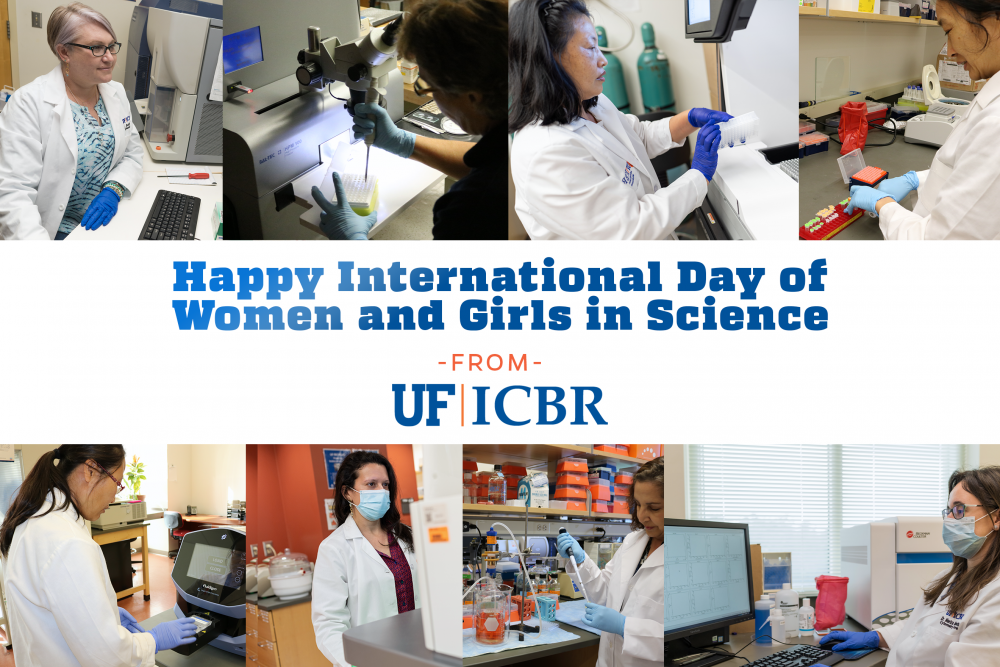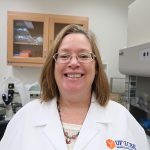International Day of Women and Girls in Science at UF | ICBR
This February 11th, please join UF | ICBR in celebrating the International Day of Women and Girls in Science!
Numerous studies have found that women in STEM fields publish less, are paid less for their research and do not progress as far as men in their careers. And while women have led ground-breaking COVID-19 research into public health, vaccines, treatments and innovative technology, the pandemic is poised to widen the existing gender disparities (especially for women scientists at the early stages of their career). The International Day of Women and Girls in Science was established in 2015 by the United Nations General Assembly to recognize the critical role women and girls play in science and technology. Since then, February 11 is the day women in organizations around the world gather each year to share their experiences in science and technology.
According to UNESCO’s forthcoming Science Report, only 33 percent of researchers are women, despite the fact that they represent 45 and 55 percent of students at the Bachelor’s and Master’s levels of study respectively, and 44 percent of those enrolled in PhD programs. At UF | ICBR, women make up 50 percent of staff, and account for over 45 percent of leaderships roles.
We sat down with UF | ICBR Director, Dr. Anna-Lisa Paul, and core directors Dr. Angel Sampson and Dr. Yanping Zhang to share their thoughts on the field of science and technology.
Why do you think the International Day of Women and Girls in Science is so important?
“Although we as a society intellectually recognize that scientists comprise every variety of human on the planet, and acknowledge that women are equally capable as men in scientific careers, women are still underrepresented in many scientific disciplines, particularly in leadership positions. So it is very important to help young girls envision themselves as scientists, and help women early in their careers be steadfast in their conviction they belong.”
– Dr. Anna-Lisa Paul
- “When women scientists of all cultures/races are promoted, girls all over the world benefit because they can see scientists and researchers that look like them.” – (AS)
- “It is important because it is encouraging for girls to see how their interests can distribute to society and be helpful to people.” – (YZ)
How did you become a researcher or scientist?
“I was hooked on science after taking my first microbiology course in community college. The fact that bacteria share DNA through transduction, transformation, and conjugation was exciting and fascinating to me. I wanted to learn more about cells, and so I did and continue to do.”
– Dr. Angel Sampson
- “I always liked math, organic chemistry when I was in high school and college. I liked the problem-solving steps. Therefore, I chose post-harvest fruit storage major in my graduate program. My project is to use transgenic technology to prolong the storage time of tomato. From there, my research life started.” – (YZ)
- “I have been interested in science since I was very little, and when asked what I wanted to be when I grew up my reply was always “a scientist”. So how did I become one? By keeping that focus in every level of schooling, and always refining my studies to what excited me most. Eventually that led me to plant molecular biology because I was fascinated by how plants work and respond to their environment as sessile organisms. This then led me to wonder how they respond to novel environments that are outside their evolutionary experience, and that led me to explore plant responses to extreme terrestrial environments and space.” – (ALP)
What makes the field of research attractive to you?
“The most attractive aspect of my job is that I can see new technologies and implement them.
I am so happy to see that our efforts can be helpful for researchers in science field.”
– Dr. Yanping Zhang
- “Research is, by its nature, a puzzle. There is nothing more invigorating than discovery.” – (AS)
- “I love to explore. I love to understand how things work, particularly the foundations of those workings; for me this goes back to molecular genetics, but there are some who say “you want foundations? Be a physicist”! So this is a great example of you have to find what is right for you! Finding what field resonates with your own sense of life is what makes a career in science exciting and a joy every day.” – (ALP)
What are some of the most exciting opportunities for your field right now?
- “Single cell multiomics is the opportunity for researcher to look at the cell morphology and gene expression simultaneously, allowing scientist to understand host-pathogen interaction and diseases. This allows scientist to better to discover novel insights into disease pathology and clinical translational research.” – (YZ)
- “Exciting opportunities in the field of antibody development include clinical monoclonal antibody therapies, vaccine development, Ig-Seq, computer-aided (artificial intelligence) antibody design, etc.” – (AS)
- “For me it is being able to take my scientific questions in plant biology off planet to experience the spaceflight environment and also explore what we humans need to understand before we can thrive in extended extraterrestrial environments like the Moon or Mars.” -(ALP)
What would you like to see universities do to increase female involvement?
- “Universities should implement gender equity policies and practices that impact faculty recruitment, hiring, retention, and retirement. The number of women graduating from specific STEM fields should be reflected in the number of female associate and full professors per department/college.” – (AS)
- “Further invest in mentoring and professional development programs for women on the cusp of dedicated careers in science, such as senior graduate students and post-doctoral researchers considering their options. We have a far higher proportion of women grad students and post docs, than women in just the next step of a professional career; where do they go?” – (ALP)
More Facts about Women in Science and Technology
- Nearly 80% of the health care workforce are women, but only about 21% of health executives and board members are women, and only about a third of doctors. And, women are more highly represented in lower-paying fields, such as home health workers, nurses and the lower-paying specialties such as pediatricians.
- Men in STEM annual salaries are nearly $15,000 higher per year than women ($85,000 compared to $60,828). And Latina and Black women in STEM earn around $33,000 less (at an average of around $52,000 a year).
- Only around 21% of engineering majors are women and only around 19% of computer and information science majors are women.
- Women are typically given smaller research grants than their male colleagues and, while they represent 33.3% of all researchers, only 12% of members of national science academies are women.
- In cutting edge fields such as artificial intelligence, only one in five professionals (22%) is a woman.
- Despite a shortage of skills in most of the technological fields driving the Fourth Industrial Revolution, women still account for only 28% of engineering graduates and 40% of graduates in computer science and informatics.





